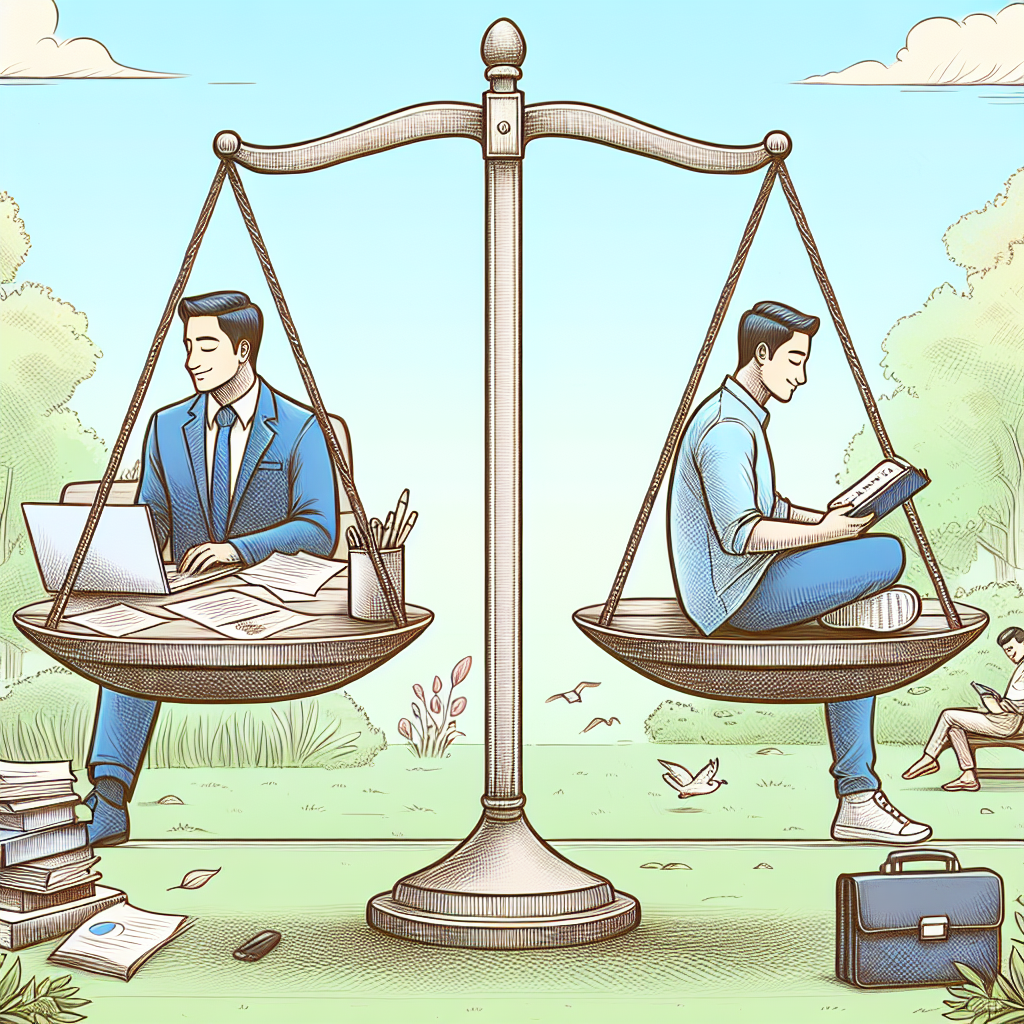Master the Art of Balancing Work and Leisure: Your Guide to a Happier Life
In the fast-paced, digitally connected world we live in today, the lines between work and leisure have become increasingly blurred. The rising demands of professional life often overshadow the essential need for personal time, leading to a dangerous imbalance that can negatively impact both mental and physical health. As we strive for career success and personal fulfillment, mastering the art of balancing work and leisure has never been more crucial.
Understanding the Concept:
Balancing work and leisure involves managing one’s time and energy in a way that allows for both career productivity and personal enjoyment. It’s about creating a harmonious equilibrium where neither work nor leisure is neglected, but rather both are given their due importance. This balance is critical for maintaining overall well-being and ensuring sustained productivity in the long run.
The importance of this balance cannot be overstated. Research consistently shows that those who achieve a healthy work-life balance experience less stress, better mental health, and a greater sense of happiness and life satisfaction. Moreover, a balanced life can lead to increased creativity and productivity, as it allows individuals to recharge and return to work with renewed vigor and focus.
Challenges in Achieving Balance:
Despite its clear advantages, many individuals struggle to find this sweet spot. The gamut of challenges ranges from the pervasive "always-on" culture perpetuated by technology to personal and professional expectations that demand ever-increasing time and effort.
-
Technological Advancements: While digital communication tools have revolutionized how we work, they have also made it more difficult to disconnect. Emails, instant messages, and virtual meetings keep employees tied to their jobs even outside office hours, eroding leisure time.
-
Competitive Work Environments: In highly competitive industries, there is often an unspoken pressure to go above and beyond. This can lead to a culture of overwork, where long hours are not only encouraged but expected.
-
Personal Expectations: Individuals sometimes place undue pressure on themselves to excel in both work and personal arenas, pushing them to sacrifice rest and recreation in pursuit of ambitious goals.
- Fear of Missing Out (FOMO): Social media and societal pressures can lead to FOMO, compelling people to engage in various activities without considering their own need for downtime, leading to burnout.
Practical Strategies for Achieving Balance:
-
Set Clear Boundaries:
- Create clear boundaries between work and personal time. This could be as simple as not checking work emails after a certain time in the evening.
- Use technology to your advantage by setting "do not disturb" modes during leisure hours.
-
Prioritize and Plan:
- Prioritize tasks by identifying what’s urgent versus what’s important, and allocate time accordingly.
- Use tools such as calendars or apps to plan out your day and ensure there is a healthy mix of work and personal activities.
-
Adopt Flexible Work Practices:
- If possible, negotiate flexible work arrangements with your employer to better accommodate personal responsibilities and leisure.
-
Practice Mindfulness and Self-Care:
- Incorporate mindfulness techniques such as meditation or yoga to help reduce stress and increase focus.
- Pursue hobbies and activities that bring joy and relaxation.
- Learn to Say No:
- Master the art of saying no to commitments that do not align with your priorities or values, whether they are professional or personal.
Real-Life Case Studies:
Consider the case of Sarah, a project manager in a tech firm, who successfully transformed her work-life balance. Initially overwhelmed by demanding work schedules, Sarah decided to implement strict boundaries on her work hours. By dedicating her weekends to family and disconnecting from emails after 7 p.m., she found that her productivity during work hours actually increased as her mental clarity improved due to adequate rest.
Another example is Jack, an entrepreneur who understood the value of taking breaks. Jack introduced a “no meetings after 3 p.m.” policy in his startup, allowing his team—and himself—time to focus on creative projects or personal development before the end of the workday. This not only boosted morale but also spurred innovation within the team.
Addressing Common Misconceptions:
-
Misconception 1: High Productivity Requires Long Hours: There is a prevalent belief that more hours equate to more output. In reality, quality trumps quantity, and working smarter, not harder, often leads to better results.
-
Misconception 2: Leisure is a Waste of Time: Some assume that leisure time is unproductive. On the contrary, leisure can enhance problem-solving skills and creativity, ultimately benefiting professional endeavors.
- Misconception 3: Balance is a One-Size-Fits-All: Work-life balance is highly personal and varies for everyone. What works for one person may not fit another’s lifestyle or responsibilities.
Actionable Advice for Readers:
To embark on the journey towards a more balanced and joyful life, start small. Identify one area where you can realistically incorporate change. Perhaps it’s setting a digital curfew or carving out 30 minutes a day for a hobby. Listen to your body’s cues for rest and relaxation, and resist societal pressures to constantly "do more." Remember, the ultimate goal is not to perfectly balance the scales every day but to align your efforts with your values and priorities, creating a sustainable lifestyle that supports both your professional ambitions and personal well-being.
Mastering the art of balancing work and leisure is not an overnight achievement but a continuous practice of self-awareness and adjustment. By integrating these strategies into your life, you pave the way for a healthier, more fulfilling existence where career success and personal happiness coexist harmoniously.
Got more questions? Our personalized Work-Life Balance AI assistant is here to help. Click here to start a conversation!

